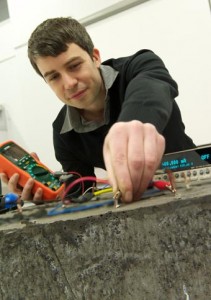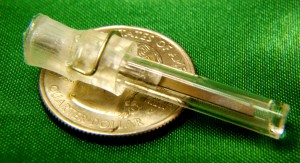I was expecting to see the Fraunhofer Institute mentioned (as I’ve covered more than one of their announcements about smart coatings) but it turns out that this smart nanotechnology-enabled paint is being developed by a research team at the University of Strathclyde (Scotland).
From the Jan. 30, 2012 news item on Nanowerk,
An innovative low-cost smart paint that can detect microscopic faults in wind turbines, mines and bridges before structural damage occurs is being developed by researchers at the University of Strathclyde in Glasgow, Scotland. [emphasis mine]
The environmentally-friendly paint uses nanotechnology to detect movement in large structures, and could shape the future of safety monitoring.
…
Dr Mohamed Saafi, of the University’s Department of Civil Engineering, said: “The development of this smart paint technology could have far-reaching implications for the way we monitor the safety of large structures all over the world.
There are no limitations as to where it could be used and the low-cost nature gives it a significant advantage over the current options available in the industry. The process of producing and applying the paint also gives it an advantage as no expertise is required and monitoring itself is straightforward.”
The paint the researchers have been testing is made with fly ash, a recycled waste product, and carbon nanotubes. Mixed together, the ingredients yield a paint with properties similar to cement.
Sam Shead in his Jan. 30, 2012 article for The Engineer explores some of the technical aspects with David McGahon, the researcher who initiated the project as part of his PhD work. One of the aspects making this smart paint possible is that the carbon nanotubes in it can carry an electrical current and changes in the state of a structure can be detected should the carbon nanotubes on the structure bend and affect the electrical current. Excerpted from the article,
… bending is detected by electrodes incorporated within the structure and therefore any significant change in the flow of electrical current can be interpreted as a sign of a structural defect.
…
… wireless communication nodes [in the structures] will be powered in part by a battery but are also expected to rely on energy-harvesting methods where possible.
‘If you’re in a tunnel, you can use the vibrations of cars or trains going past to harvest power. If you’re on a bridge, you could maybe use a solar panel,’ said McGahon. ‘The idea is to make it more sustainable so you’re not running out to your bridge or structure to change the battery all the time.’
If you want to get more technical understanding of the work, I highly recommend Shead’s article.
The news item on Nanowerk offers some more ‘big picture’ details,
“Wind turbine foundations are currently being monitored through visual inspections. The developed paint with the wireless monitoring system would significantly reduce the maintenance costs and improve the safety of these large structures.
“Current technology is restricted to looking at specific areas of a structure at any given time, however, smart paint covers the whole structure which is particularly useful to maximise the opportunity of preventing significant damage.”
The research has been carried out at Strathclyde with Dr Saafi working alongside David McGahon, who initiated the work as part of his PhD project. With fly ash being the main material used to make the paint, it costs just one percent of the alternative widely used inspection methods. [emphasis mine]
A prototype has been developed and tests have shown the paint to be highly effective. It is hoped further tests will be carried out in Glasgow in the near future.
Dr Saafi added: “We are able to carry out the end-to-end process at the University and we are hoping that we can now demonstrate its effectiveness on a large structure.
If you’re at all curious as to what this smart paint looks like here’s an image of David McGahon with a wireless device and the paint (from the University of Strathclyde’s Jan. 30, 2012 news release),
Very exciting stuff!

